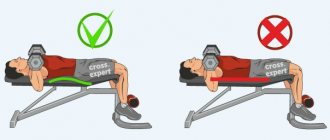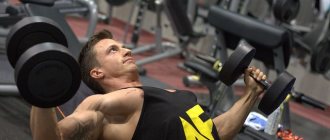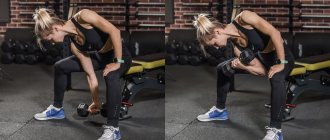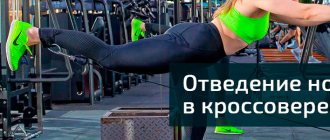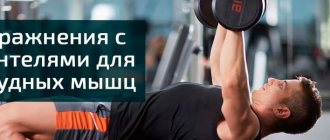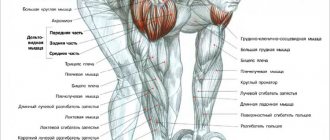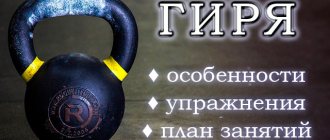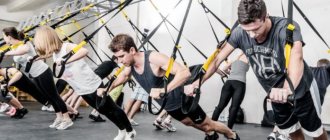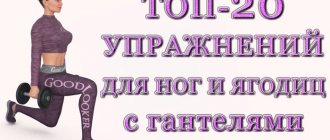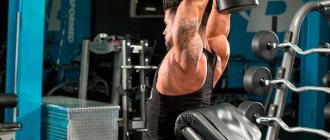Article written by a qualified trainer
If you want to build up your arm muscles at home, we recommend getting dumbbells with weight increments of 1-2 kg. Why dumbbells? Because this type of weight allows the trainee to make more natural movements, and thereby increase the effectiveness of the natural load on the trained muscles. And, of course, this is the most common equipment for home training. In your circle, probably every third person has a pair of dumbbells at home. There is only one requirement for “home” dumbbells - they must be collapsible to be able to use a wide range of weights.
To understand how to pump up your arms with dumbbells, you need basic knowledge of anatomy. Therefore, let's move on to muscle structure.
A tour of the arm muscles
The main functions of the arm muscles are quite simple: the triceps straightens the elbow, the biceps flexes the elbow. But there are still some points for a detailed understanding of the work of the arm muscles.
Biceps
The biceps (biceps brachii) is a flexor muscle consisting of two heads (muscle parts). The tendon of the long head of the biceps brachii muscle passes through the cavity of the shoulder joint, while the short head, located on the inside, does not reach the shoulder joint. These heads act as a single muscle, pulling the bones of the forearm towards the shoulder, and also performing some secondary functions.
It is the long head that creates the “ball”, which is a symbol of the “pumped up” biceps. And the short head determines the length and thickness of this muscle. The length of your biceps is determined genetically, and it is almost impossible to significantly change it.
The function of the biceps is to flex the arm, i.e. bringing the forearm closer to the shoulder. In this case, it does not matter what position the hand is in at the beginning of the movement: above the head or at the hips. Also, the biceps performs supination - a movement in which the forearm rotates from the natural “palm in” position to the “palm up” position.
Brachialis
The brachialis (brachial muscle) is a voluminous and strong muscle. Its peculiarity is that it will not be visible on the hand until the trainee is in fairly good athletic shape. With minimal development of the arm muscles, the brachialis will move the biceps upward. In this case, it will be distinguishable in the form of a bump on the outside of the arm.
The brachioradialis (brachioradialis) is also one of the most prominent muscles of the arm: it is the largest muscle of the forearm. It can be seen even on the hands of thin people. This muscle is not as “popular” as the biceps and triceps. Regardless of whether you know about it or not, it develops along with your brachialis.
The function of the brachialis and brachioradialis is flexion of the elbow joint when the palm is in a natural or neutral position. The brachialis is not involved in other movements. But brachioradialis is more universal: it is involved in turning the forearm into a supination position (the palm turns outward) and into a pronation position (the opposite rotational movement of supination, occurring inward).
Triceps
Triceps (triceps muscle) is a large muscle group, making up about 2/3 of the total muscle mass of the shoulder.
Many people don’t think about this and pay all their attention to the development of biceps. The triceps consists of three heads: long (located on the back of the arm), lateral (on the outside of the arm) and medial (located below the long head). It is the lateral and long heads that form the very “horseshoe”, which is a symbol of a perfectly “pumped up” triceps. The function of the triceps is to straighten the elbow joint. Moreover, just like the biceps - from any position. At the same time, the long head of the triceps also helps the back and arm muscles lower the raised arm.
How to choose the working weight of dumbbells
Choose the initial weight of dumbbells so that the last 1-2 repetitions planned in each approach are a little difficult (but the execution technique remains clear). For example, I did 10, but in general I could have done 12-13 with all my might. These 12-13 are with tension and enormous effort, but this is not necessary - so if the given weight allows, do 10! (in this example).
But in the last approach of each exercise you need to do maximum repetitions! Those. achieve muscle failure in the last approaches. And precisely with a clear technique, ensuring the safety of execution: without jerking, without swinging and other “help” with the body.
Next, delving into the question of how to pump up arm muscles with dumbbells, we will, of course, move on to exercises. Moreover, to the most effective of them.
Biceps exercises
STANDING ARM CURL WITH DUMBBELLS
This exercise is a “classic” for an excellent workout for the biceps and forearm muscles.
Starting position:
We take dumbbells in our hands, stand up, back straight, arms with dumbbells down. The palms are turned forward (back to the hips).
Performance:
Keeping your elbows static (pressed to your body), with a powerful explosive movement, lift the dumbbells up to mid-chest level, bending your elbows (contracting your biceps).
Only the forearms move! Having reached the top point, we linger at the peak point for 1-2 seconds, then slowly lower the dumbbells into IP. At the lowest point, without a pause, we immediately begin to bend our arms “non-stop” again. We repeat the movement until we complete all the planned repetitions.
Only the elbow joint works! The shoulder does NOT work here! Therefore, the top point is at chest level, not neck level!
STANDING ARM CURL WITH NEUTRAL HAMMER GRIP
The peculiarity of this exercise is that in addition to the biceps, the brachialis and brachioradialis are used and are perfectly trained.
Starting position:
We take dumbbells in our hands, stand up, back straight, arms with dumbbells down. Palms are turned towards the hips. The dumbbell bars are parallel to each other.
Performance:
Keeping your elbows static (pressed to your body), bend your arms with a powerful explosive movement, keeping parallel between them. Raise the dumbbells so high that further movement with fixed shoulders is impossible.
Let's hold at the peak point for 1-2 seconds, then slowly lower our hands into IP. At the lowest point, without a pause, we immediately begin to bend our arms “non-stop” again. We repeat the movement until we complete all the planned repetitions.
Only the elbow joint works! The shoulder does NOT work here!
Biceps anatomy
The biceps is a very small muscle group. This biceps muscle begins under the deltoid and continues below the scapula. Its basic function is to rotate the wrist and flex the arm.
Because a powerful physique is associated with big arms, many athletes focus their energy and attention on building biceps.
These smaller muscle groups tend to respond differently to larger muscle groups because they have limited participation in daily activities outside the gym. They will respond almost immediately to any stimulation because they don't work much. When we start training, it is an extreme shock to the body, in this case to the biceps. In response to the shock, the biceps begins to adapt to it and becomes larger and stronger.
You can read more about the anatomical features of biceps training here. And now we will step by step analyze an excellent workout for biceps, which you will perform exclusively with dumbbells.
Triceps exercises
ARM EXTENSION WITH DUMBBELLS FROM BEHIND THE HEAD, SITTING
This exercise works great on the triceps, especially the long head, which of all 3 heads gives the largest volume to the entire muscle.
Starting position:
We take dumbbells in our hands, sit on a bench or any other strong and reliable piece of furniture, straight back, raise the dumbbells up with outstretched arms. The dumbbell bars are parallel to each other. The back is straight, the neck is in a natural position (the head cannot be tilted forward).
Performance:
Slowly bend your elbows, bringing the dumbbells back behind your head. Maintain a fixed position of your elbows and shoulders. Having reached the bottom point and feeling the tension in the triceps, we extend our arms in IP. When extending your arms, your elbows should also remain motionless. At the top point, without a pause, we immediately begin “non-stop” to bend our arms again under the influence of the gravity of the dumbbells. We repeat the movement until we complete all the planned repetitions.
Only the elbow joint works!
ARM EXTENSION WITH A DUMBBELL IN AN INCLINE WITH STOP
In this exercise, the triceps (especially the upper part) are actively worked, and the deltoid, latissimus dorsi and trapezius muscles receive secondary load.
Starting position:
We take a dumbbell in our right hand with the palm facing us, rest our left hand and left knee on a bench or any other strong and reliable piece of furniture. The back is straight, the neck is in a natural position (there is no need to lift your head). We bend the arm with the dumbbell at the elbow and move it back. The upper part of the arm (from the elbow to the shoulder) should be parallel to the spine.
In the initial position, the elbow is bent at a right angle and pressed as close as possible to the body.
Performance:
Maintaining a fixed position of the elbow and shoulder, we straighten the arm with the dumbbell, moving it back and up and turning the palm back (away from ourselves). At the highest peak point we feel the tension in the triceps, then slowly return the hand to IP.
We repeat the movement until we complete all the planned repetitions.
When all the planned repetitions are completed with the right hand, we “mirror” the position and perform the same number of extensions with the left hand.
Main conclusions
It is quite difficult to make your arms massive and sculpted, but this is possible if you follow these rules:
- Start your workout with a warm-up and end with stretching.
- Improve your technique at first, and then use dumbbells.
- Choose an exercise equipment that you can perform 6 to 12 repetitions with force.
- Gradually increase the weight of your inventory.
- Periodically change the positions of the exercises, supplement the program with new elements.
- Train 1-2 times a week.
- Work at full amplitude, fixate on the extreme point.
- Eat right.
- Set aside separate days to work on your hands. On other days, train other muscle groups so that the body develops harmoniously.
Be patient, put in your own efforts, and soon you will notice impressive results.
Breathing while doing exercises
Biceps exercises : inhale - when you slowly lower the dumbbells down, exhale - when you raise your arms with dumbbells, bending your elbows.
Triceps exercises : inhale - when you slowly lower the dumbbells down, exhale - when you straighten your arms with dumbbells.
The given exercises will be the best answer to the question of how to pump up your arms with dumbbells at home. Because these are the most effective movements from the entire arsenal that are best suited for home workouts. And for them you will only need dumbbells and any strong and reliable piece of furniture on which you can perform exercises while sitting or lean on it.
Training scheme
WEEKLY SPLIT
When organizing a weekly training split, various combinations have been used since the 70s of the 20th century:
- combining large and small muscle groups in “one movement” : triceps are trained with the chest muscles, and biceps - on the back day;
- combining large and small muscle groups of “opposite movements” : triceps are trained on back day, and biceps with pectoral;
- highlighting the arm muscles on a separate training split day.
Each of these options has proven effective among a large number of athletes and professional athletes. As often happens in fitness, the first option is suitable for one person as the most effective, for another – the second, etc. Everything is selected individually , so over time, try all three combination options, and then you will find out which one will be the most optimal for you.
The frequency of training also needs to be selected individually, taking into account genetics. Don’t forget that the arms, although secondary, still work in many exercises for the chest and back. For most trainees, the option of training a muscle group (for example, triceps) 2 times a week : every fourth or fifth day (from the last training of this group).
SET AND REPS
An example of a load designation - 3*10-15 means three sets of 10-15 repetitions. For the above exercises, the training plan is as follows:
| A week | Sets and reps | Rest between sets |
| 1 | We perform each exercise 2*8-10 | 120 seconds |
| 2 | We perform each exercise 3*10-12 | 90 seconds |
| 3 | We perform each exercise 4*10-15 | 120 seconds |
| 4 | We perform each exercise for 3 approaches, changing the weight for each approach: the first - 12-15 repetitions, the second - 10-12 repetitions and the third - 8-10 repetitions | 90 seconds |
Don't forget about the warm-up approach for each exercise . It is performed with 40-50% of the working weight for 12-15 repetitions. The warm-up approach is not counted in the program; only working approaches are taken into account. And, of course, before starting a workout, be sure to do a joint warm-up. It will prepare your muscles and joints for intense work and significantly reduce the risk of injury.
After completing a 4-week training program, give your muscles and central nervous system a rest - give up weight training for 7 days .
From the fifth week, the “passing” of the scheme for the first four weeks is repeated, and the weight of the weights in each exercise should increase . Even if only by 0.5 kg on one dumbbell. Or maybe 1 kg. This will depend on how technically the exercises are performed, how long and high-quality your sleep is, and on the sufficient amount of proteins and carbohydrates in your diet. Thus, we come to the features in the methodology of development of arm muscles.
General recommendations
One of the most common mistakes many novice bodybuilders make is that they enthusiastically start training and pump their biceps every day. Such an approach not only does not bring results, but also exhausts the athlete.
Constant and regular stress on the muscles, which does not give the desired effect, can lead to reluctance to continue training and a gradual decrease in physical activity. Avoiding such consequences allows you to clearly understand that muscles grow only when training alternates with rest.
If the athlete has a bench press rack at his disposal, it is best to perform deadlifts and rows with a reverse grip, and squats with a barbell. Both isolating and complex exercises, provided regular training and proper execution, give guaranteed results.
And, as mentioned earlier, the main thing is that during the training both small and large muscle groups are involved, that is, one training is devoted to pumping up the triceps and back, and the other to the biceps and chest.
Of course, for some, this approach may not seem the most optimal, but it is supported by personal experience and has demonstrated its effectiveness.
General principles of arm training for muscle growth
SEQUENCE OF EXERCISES
The right combination of exercises will be key to stimulating maximum muscle gains in your arms.
Therefore, in the first month, work out your biceps and triceps in exactly the order indicated above.
From the second month onwards, use “alternation”: all sets of one biceps exercise, then all sets of one triceps exercise, then biceps again, etc. This will allow muscle groups to get more rest during the workout, which in turn will allow you to use heavier weights than before.
VARIETY OF MOVEMENTS
After 3 months according to this scheme, we recommend including in the program such exercises as:
- Narrow push-ups
- Reverse push-ups
- Concentrated bent over arm curls
- French bench press with dumbbells
- Extension of the arm with a dumbbell from behind the head while standing or sitting
- Seated hammer curls.
With the above options you can replace the exercises of the current program, but only one at a time, so that at least one of the “first” exercises is always in the program.
Is it even possible for a 13, 14, 15 year old teenager to get pumped up?
In fact, it all depends on your genetics. It will be the hardest for guys who have arms like the legs of a sparrow, and whose ribs are more prominent than their abs. Gaining weight as a teenager is very difficult.
If you're a chubby lover of grandma's pies, then this will be a little easier for you.
advertising is not displayed
The main difficulty will be nutrition. I remember my childhood and how we spent from morning to evening on the street and we clearly had no time for food. Everyone, with the exception of plump Seryozha, he always had a bun in his pocket.
Therefore, if you decide to become a pumped-up male, then be prepared for the fact that you will have to go home and eat on a schedule.
The next difficulty is that you won’t be able to push yourself too hard in the gym. The fact is that at this age the spine has not yet formed; if you give a large axial load, this can lead to dire consequences. Therefore, I would advise you to first use the services of a personal trainer.
But, despite all these difficulties, it is possible for a teenager to get pumped up. The main thing is that you have a desire and approach this matter responsibly.
Principles of recovery
Training is undoubtedly in first place in importance. Well, second place is shared by nutrition and recovery. Without these two, even the most ideal training program for you will not give the desired results. During training, we create a stimulus for muscle growth, from nutrition we receive “building materials” for muscle growth, and this happens for the most part at night during quality sleep.
NUTRITION AS THE BASIS OF MUSCLE GROWTH
Now let’s take a closer look at those very “building materials” for muscle growth.
- Squirrels. The protein norm for a person involved in fitness is 1.2-1.6 g/1 kg of body weight.
- Fats. The norm of fat is 1g/1kg of body weight.
- Carbohydrates. The carbohydrate content in the diet is 200 grams per day. This is a “starting point”, then it needs to be adjusted depending on the feedback of each specific organism. Those. If you feel good, your workouts are going well and according to plan, the weights of the weights increase, and at the same time the volume of your arms increases (according to measurements), then this carbohydrate norm is selected correctly. Continue to stick to it further. If everything described is not observed for you, then increase carbohydrates by 50 grams from the daily norm and track progress according to the specified criteria for another 2 weeks. If necessary, repeat increasing carbohydrate intake.
NIGHT RESTORATION OF THE BODY
You need to sleep at least 8 hours a day . Moreover, this should be precisely a continuous “high-quality” night’s sleep. Now you know everything about pumping up powerful biceps and triceps. And when you, having pumped up your arm muscles to the point of envious glances, are asked about how to pump up your arm muscles with dumbbells, you will feel like a Great Teacher and will be proud to share the practical knowledge that is presented in this article.
bicepsbrachipsdumbbellsarmshomeworkoutmatrixps
A little anatomy
First you need to understand why forearms are so difficult to pump. To do this, you will have to open a reference book on anatomy, but you can explain everything on your fingers.
You need to start with the bones. Unlike the shoulders, and the main girdle that supports the muscles, the bones of the forearms consist of two main radial processes, which are much thinner than the others, this allows the wrists to rotate along their axis without any problems, providing high mobility of the hands. In return, you have to pay with force, since attaching large muscles to such thin bones is simply irrational from the point of view of optimizing the body's resources.
The second reason is even more prosaic. The forearm muscles are a complex multifunctional group of small fibers, each of which is responsible for its own action. Finger mobility is provided by as many as 5 muscle groups, while shoulder mobility is provided by 2 main groups. There are also muscles responsible for flexing the hand itself. This means that in order to pump up your arms, you need to try to use more exercises aimed at different small muscle groups. Namely:
- Brachialis;
- Brachioradialis;
- Flexors;
- Extensors;
- Round ponator.
Moreover, if an athlete is not involved in armlifting, then the main task is to pump up the flexors and extensors.
